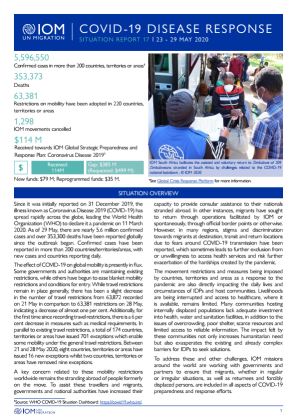-
Countries
-
Data and Analysis
-
Special Focus
-
Crisis Responses
IOM COVID 19 Response - Situation Report 17 (29 May 2020)

Contacter
COVID Response HQ - covid19ops@iom.int
Langue
English
Emplacement
Global
Période couverte
May 23 2020
May 29 2020
Activité
- Other
- Points of Entry (PoE)
Since it was initially reported on 31 December 2019, the illness known as Coronavirus Disease 2019 (COVID-19) has spread rapidly across the globe, leading the World Health Organization (WHO) to declare it a pandemic on 11 March 2020. As of 29 May, there are nearly 5.6 million confirmed cases and over 353,300 deaths have been reported globally since the outbreak began. Confirmed cases have been reported in more than 200 countries/territories/areas, with new cases and countries reporting daily.
The effect of COVID-19 on global mobility is presently in flux. Some governments and authorities are maintaining existing restrictions, while others have begun to ease blanket mobility restrictions and conditions for entry. While travel restrictions remain in place generally, there has been a slight decrease in the number of travel restrictions from 63,872 recorded on 21 May in comparison to 63,381 restrictions on 28 May, indicating a decrease of almost one per cent. Additionally, for the first time since recording travel restrictions, there is a 6 per cent decrease in measures such as medical requirements. In parallel to existing travel restrictions, a total of 174 countries, territories or areas have issued 701 exceptions which enable some mobility under the general travel restrictions. Between 21 and 28 May 2020, eight countries, territories or areas have issued 16 new exceptions whilst two countries, territories or areas have removed nine exceptions.
A key concern related to these mobility restrictions worldwide remains the stranding abroad of people formerly on the move. To assist these travellers and migrants, governments and national authorities have increased their capacity to provide consular assistance to their nationals stranded abroad. In other instances, migrants have sought to return through operations facilitated by IOM or spontaneously, through official border points or otherwise. However, in many regions, stigma and discrimination towards migrants at destination, transit and return locations due to fears around COVID-19 transmission have been reported, which sometimes leads to further exclusion from or unwillingness to access health services and risk further exacerbation of the hardships created by the pandemic.
The movement restrictions and measures being imposed by countries, territories and areas as a response to the pandemic are also directly impacting the daily lives and circumstances of IDPs and host communities. Livelihoods are being interrupted and access to healthcare, where it is available, remains limited. Many communities hosting internally displaced populations lack adequate investment into health, water and sanitation facilities, in addition to the issues of overcrowding, poor shelter, scarce resources and limited access to reliable information. The impact felt by these communities not only increases humanitarian need but also exasperates the existing and already complex barriers for IDPs to seek solutions.
To address these and other challenges, IOM missions around the world are working with governments and partners to ensure that migrants, whether in regular or irregular situations, as well as returnees and forcibly displaced persons, are included in all aspects of COVID-19 preparedness and response efforts.
